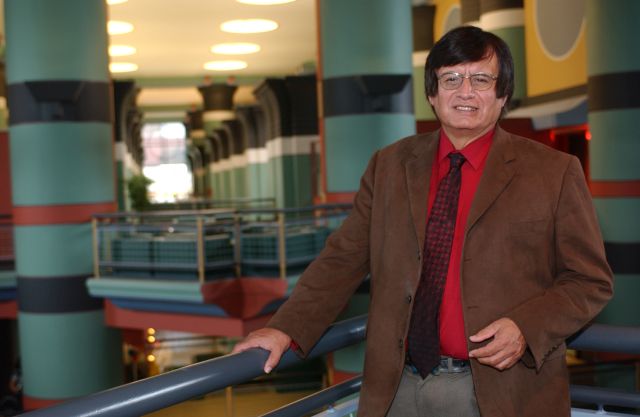
Last week, Florida’s Nova Southeastern University (NSU) announced that Broward County’s hometown university students would celebrate all things Pi. According to NSU, the Math Club soiree featured math-related activities, including the Mental Math Challenge.
During the competition, contestants were expected to wiz through questions without phones, calculators, pencils, or paper. The student who answered the most questions correctly was declared the winner.
Over at the Exploratorium in San Francisco, where Pi Day was founded in 1988, the museum hosted the 36th annual holiday celebration on March 14 (3/14).
It “commemorates the irrational, transcendent, and never-ending ratio that helps describe circles of all sizes,” the museum said. Activities included presentations, Pi parades, and free slices of pie.
NASA announced the agency was giving students a chance to join in the fun by using pi to explore Earth and space themselves in the 10th annual NASA Pi Day Challenge.
“Pi is the number that results from dividing the circumference of any circle by its diameter. Pi can be and often is rounded to 3.14 (even though its decimals never end), so 3/14 has been designated National Pi Day,” NASA said.
In 2009, Congress passed an unofficial Pi resolution. The Greek letter (π) is the symbol for the ratio of the circumference of a circle to its diameter. Since Pi can be approximated as 3.14, March 14 was a good day for National Pi Day.
In celebration of the math holiday, Hispanic Engineer dot com features an internationally known mathematician. Here are some highlights from his trailblazing career.
Dr. Richard Tapia is a professor in the Department of Computational and Applied Mathematics at Rice University. As a founding member of the Society for the Advancement of Chicanos and Native Americans in Science (SACNAS), Tapia developed methods to connect with inner-city students and teachers. One such method was the “Math is Cool” presentation.
Tapia was born in Los Angeles to parents who, separately, immigrated from Mexico as young teenagers in search of educational opportunities for themselves and future generations. He was the first in his family to attend college. He earned B.A., M.A., and Ph.D. degrees in mathematics from the University of California-Los Angeles.
In 1967, he joined the Department of Mathematics at UCLA and then spent two years on the faculty at the University of Wisconsin. In 1970 he moved to Rice University, where he was promoted to associate professor in 1972 and full professor in 1976.
Thirty-five mathematics students have received or are working on a Ph.D. under his direction or co-direction. Of these 35 students, 15 have been women, and eight have been underrepresented minorities.
In 2014, Dr. Tapia received the Vannevar Bush Award for his leadership, inspiration, and advocacy to increase opportunities for minorities in science. He was awarded the National Medal of Science in 2010, the highest honor the US government gave scientists and engineers. He also received a Distinguished Public Service Award from the American Mathematical Society.
In April 2005, Tapia was recognized as one of the 50 Most Important Hispanics in Technology and Business by Hispanic Engineer magazine. Earlier in his career, Dr. Tapia was given the College Level Educator of the Year Award by Hispanic Engineer Magazine and named one of the 20 most influential leaders in minority math education by the National Research Council in 1990.
In 1996, he received the Presidential Award for Excellence in Science, Mathematics, and Engineering Mentoring. SACNAS honored Tapia with the 2000 SACNAS Distinguished Scientist Award at their annual national meeting in Atlanta, Georgia. Tapia was selected for a lifetime of achievement in his field and dedication to the future of young scientists.
In May of the same year, Cornell University established a lecture series to honor Tapia and David Blackwell, professors at the University of California-Berkeley. The lecture series provides a forum for the research of African-American, Latino, and American Indian scientists working in the fields of mathematical and statistical sciences.
On February 22, 2023, Rice University’s Multicultural Community Relations department hosted a book presentation for Richard Tapia’s “Losing The Precious Few: How America Fails to Educate Its Minorities in Science and Engineering” in the Anne and Charles Duncan Hall’s McMurtry Auditorium.
The book identifies issues that contribute to the lack of minorities in graduate STEM programs, including dependence on standardized tests, deficiencies in K-12 education, and historic and ongoing racism.
Tapia is a University Professor, the Maxfield-Oshman Chair in Engineering, a professor of computational applied mathematics and operations research, and director of the Tapia Center for Excellence and Equity.
In a recent report, the Bureau of Labor Statistics said the overall employment of mathematicians and statisticians is projected to grow 31 percent from 2021 to 2031, much faster than the average for all occupations. About 4,100 openings for mathematicians and statisticians are projected each year, on average, over the decade. Many of those openings are expected to result from the need to replace workers who transfer to different occupations or exit the labor force, such as retiring.
The U.S. Army Corps of Engineers has been tasked with…
Brown and Caldwell, a leading environmental engineering and construction firm,…
Humboldt State University, one of four campuses within the California…